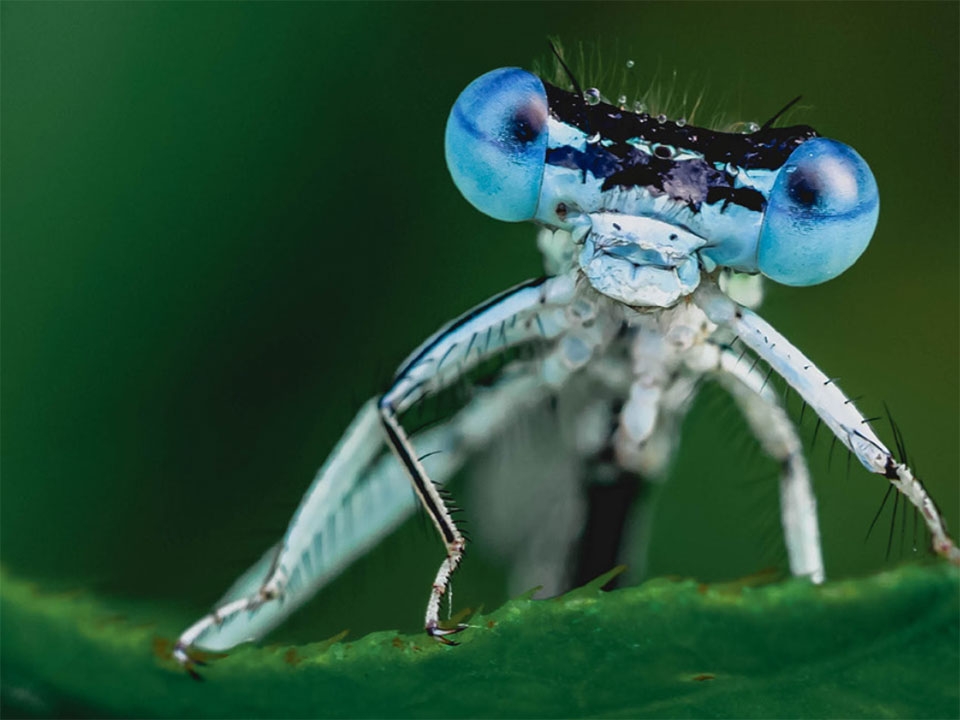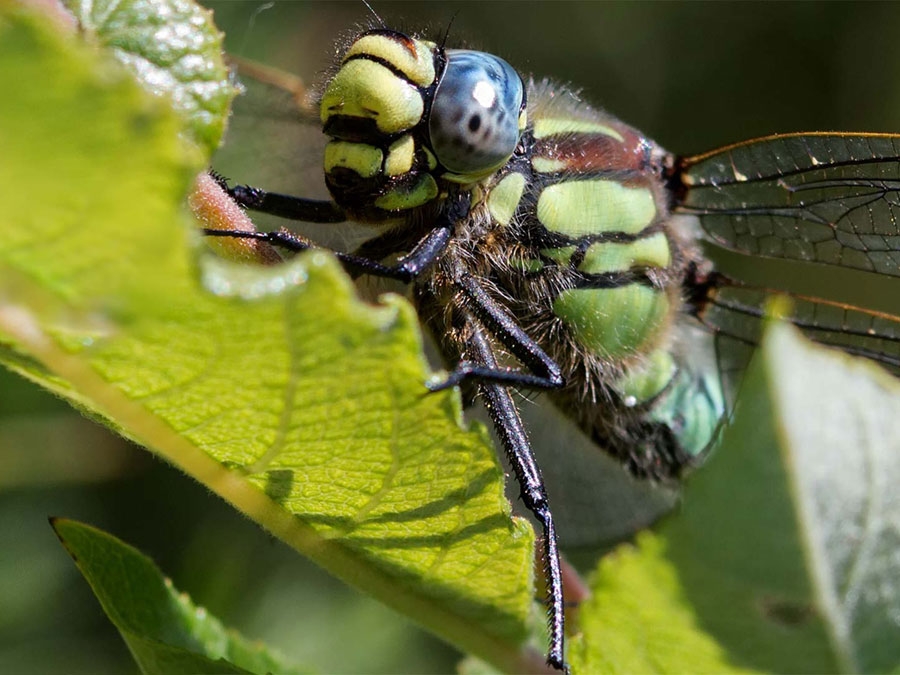How to photograph dragonflies

How to take great wildlife photos of dragonflies this summer
Summer is the perfect time to visit a wetland centre to spot dragonflies and damselflies. But how to catch them on camera? Dragonflies can be a daunting subject, being easily disturbed and when on the wing, extremely fast in flight.
Told in their own words, here we meet photographers who have stepped up to the challenge and tried their hand at capturing these tough subjects.
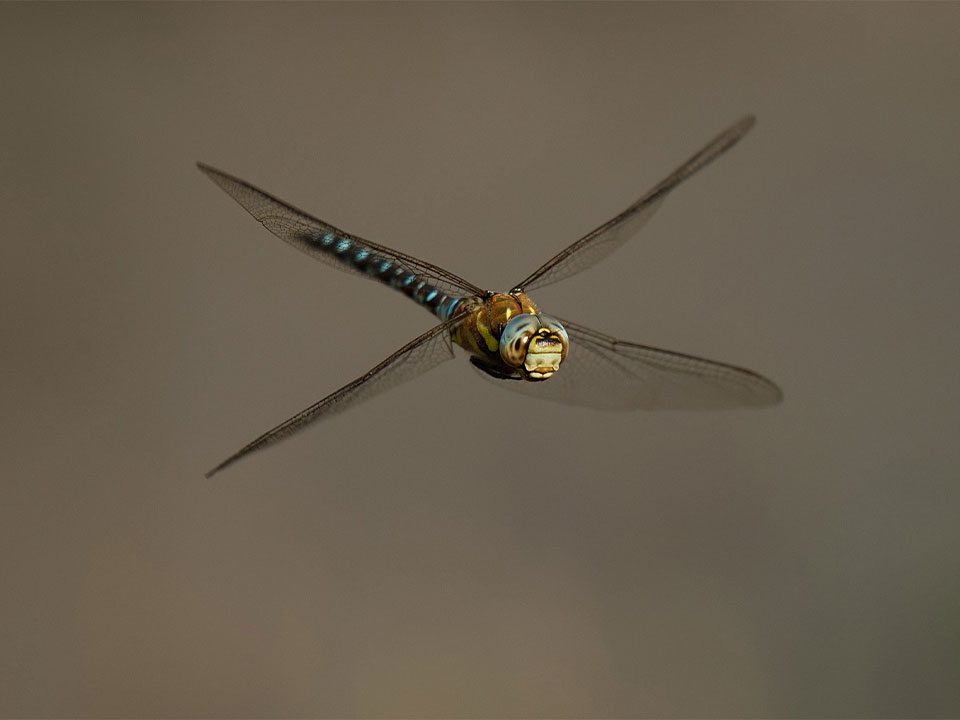
Migrant hawker (Aeshna mixta) in flight at Slimbridge, September
Jonathan Bull, WWT volunteer
The challenge
Capturing a dragonfly in flight is probably one of the hardest macro shots you can challenge yourself with and while it can be an exercise in frustration, there is no bigger pay-off than finally nailing “the shot”. Every dragonfly is different and some are definitely harder than others. Brown hawkers are my nemesis. Others can be a great starting point for getting some practice in.
Migrant hawkers are one of the more abundant large dragonflies in the late summer and their behaviour makes them one of the easier species to get flight shots of as they tend to stop and hover in place for a couple of seconds - quite generous for a dragonfly!
They’re creatures of habit, often returning to the same perch and usually hanging around a favoured area, so it’s quite easy to figure out their routine.
Getting the shot
I took this from the Robbie Garnett hide at WWT Slimbridge with a Nikon D750 and 500mm f/4G ED VR lens. It was an early September afternoon with the sunshine behind me. Essentially the perfect conditions allowing me to push the shutter-speed to 1/4000s to freeze the wing-motions. This meant I could keep my aperture wide open at f/4 (ISO 500), allowing for a smooth background. I spent about 15 minutes trying for this shot. I recommend pre-focusing on something close beforehand to cut down on focus hunting!
Male common darter (Sympetrum striolatum) at allotment pond, August
Penny Smallshire, WWT staff
The challenge
My pond is well and truly my happy place; as someone who struggles with their mental health, there are very few things as healing as sitting by the water watching pond-life go by.
It was so exciting to find dragonflies using my pond – especially only a few months after it was a muddy hole on my allotment!
Finding that a male common darter had set up territory meant I could sit and watch him for hours on end, and by putting a simple stick in the ground I had given it the perfect perch in the perfect position to photograph from the comfort of my bench.
Getting the shot
It gave me a chance to experiment with the high frame rate video setting on my Sony RX10 IV, as it kept zipping to and from its perch to see off rival males or other insects that dared enter the vicinity. I had it set to record at 1000fps and the focus and other settings all have to be done before you start recording in HFR mode, so by the time I pressed record I had missed the take-off. But I was incredibly lucky that it came back in to land in the blink of an eye; the blink of an eye that I could slow down and see in wonderful detail!
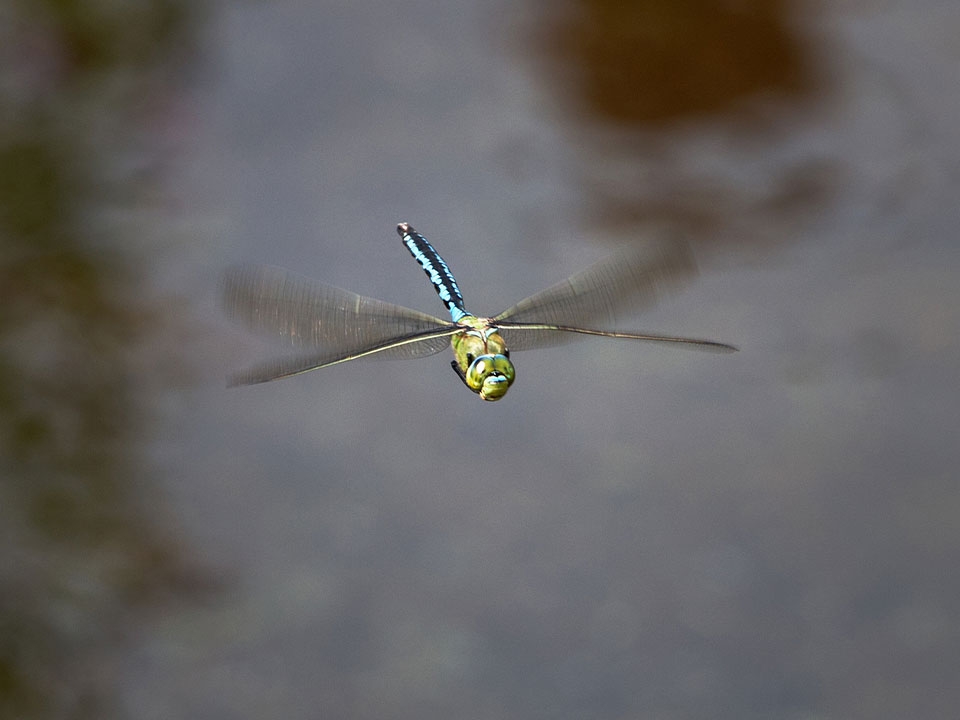
Male emperor dragonfly (Anax imperator) in flight at Castle Espie, August
Jonathan Clark, WWT volunteer
The challenge
2024 was not an ideal year for dragonflies in Northern Ireland - a late spring then an interchangeable summer and autumn - but they did appear in good numbers, eventually.
In fact, 2024 saw the first visit of emperor dragonflies to the reserve at WWT Castle Espie.
First to appear was a bright green immature male on the Brickworks. Then a very handsome blue and green male patrolling the Chimney Pond - possibly the same individual.
Emperors are strong fliers and rarely come to rest so standing by the pond waiting for a clear shot was futile.
Getting the shot
My camera of choice is a Canon EOS 70D with a Canon 100-400mm lens which has served me well. But it’s heavy and not ideal for tracking a fast-moving insect.
Plan “B” was to try patience; zoom out, set the focus manually and wait for him to zip into frame. After many failed attempts I accidentally captured a couple of shots - my first of a dragonfly in flight. This final shot was captured at just 190mm, 1/400s, f/5.6 (ISO 100) - showing that maybe you don’t need a super telephoto lens and very high shutter speed to capture the in-flight shots.
These creatures are thrilling to watch in the air and thoroughly satisfying to capture on camera.
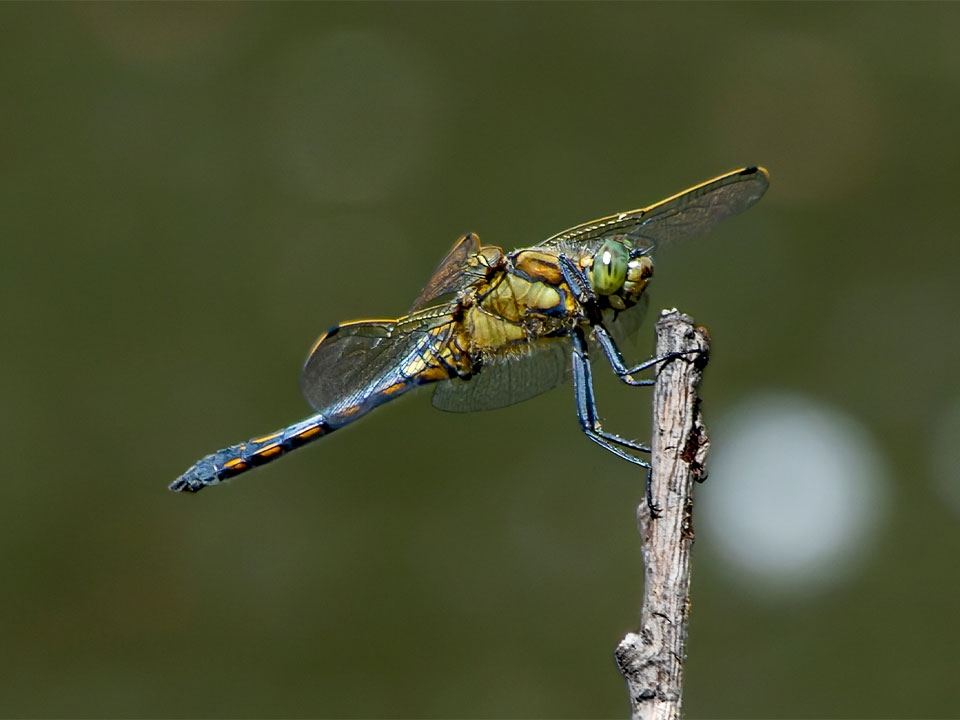
Immature male black-tailed skimmer (Orthetrum cancellatum) at Martin Mere, July
Gary Gray, WWT supporter
The challenge
Photographing dragonflies is about patience and observation. When you spot one, watch and wait. They will have a favourite stick to rest on before going on a regular hunting route. Discovering this then makes photographing them easier.
When they are resting, try to shoot them either side-on or square on their back. This will help to get as much as possible in focus. Try moving your position to get a clean uncluttered background. If it’s sunny, try playing with the light glinting on the wings.
Getting the shot
When they are at rest, you will have time to adjust your setting to a mid-range aperture, somewhere around f6.3-8 to get a good depth of field in focus. Focus on their face/head. A fast shutter is not as necessary as trying to photograph them in flight. Here, I used 1/640s (ISO 250) at 600mm with my Canon 7D Mark II.
In flight they are fast and erratic, and tend to hunt on a similar route going back to the same resting spot. They are quite territorial so watch for interaction with intruders. Knowing the route will help to photograph them in flight. A faster shutter speed will be needed. A shutter speed of 1/3000th of a second is a good starting point. Set your camera to shutter priority and let your camera decide the other setting. Practise makes perfect tracking them in flight, so expect plenty of missed/out of focus shots.
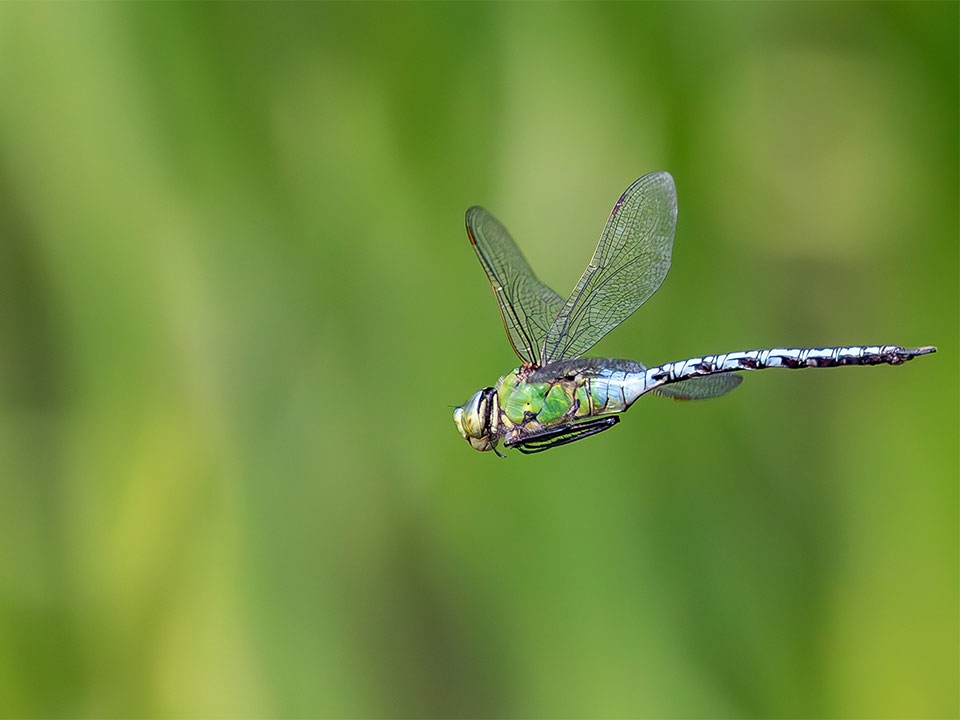
Male emperor dragonfly (Anax imperator) at Caerlaverock, July
Brian Taylor, WWT supporter
The challenge
It was a bright sunny afternoon as I walked beside the Back Pond at Caerlaverock. Carrying my trusty Canon 5D Mark IV DSLR camera with 600mm lens I was on the look-out for dragonflies.
It wasn’t long before I spotted a magnificent emperor dragonfly whizzing along the water’s edge in search of its prey. Every now and then it would hover briefly as it looked around for small insects. The sun was behind me and so it was an ideal opportunity to capture a still photograph of the radiant colours of the dragonfly as it hovered.
Getting the shot
I didn’t use a tripod, preferring to hand hold the camera to allow more freedom to get into the best position by the water’s edge. Dragonflies move around very quickly in their quest for food! I used an aperture of f8 and a shutter speed of 3,200 to achieve a sharper picture of its fluttering wings.
I abandoned the camera’s autofocus mechanism and used manual focus which was far more effective, despite requiring a lot of fine tuning.
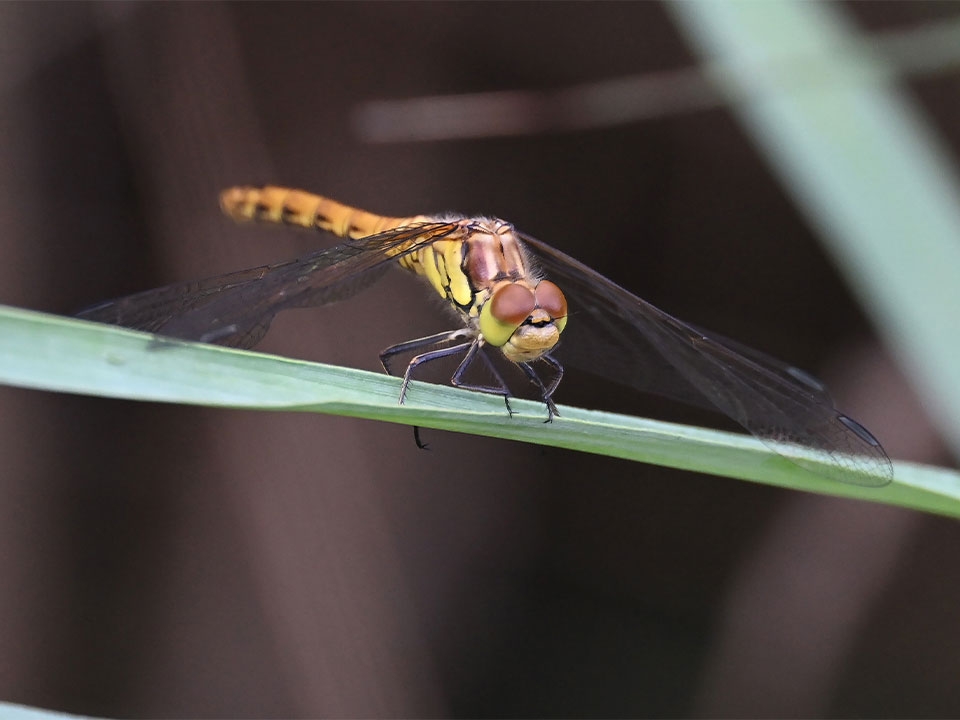
Female ruddy darter (Sympetrum sanguineum) at Steart, August
Kit Houghton, WWT supporter
The challenge
I took this during a dragonfly day at Steart Marshes, with the expert leading being amazing at locating dragonflies. Once he'd done that, it was just a matter of getting the photo!
Getting the shot
This perched dragonfly was captured with a Nikon Z8 mirrorless using 100-400 lens set at 400mm, 1/400sec f5.6 iso 800.
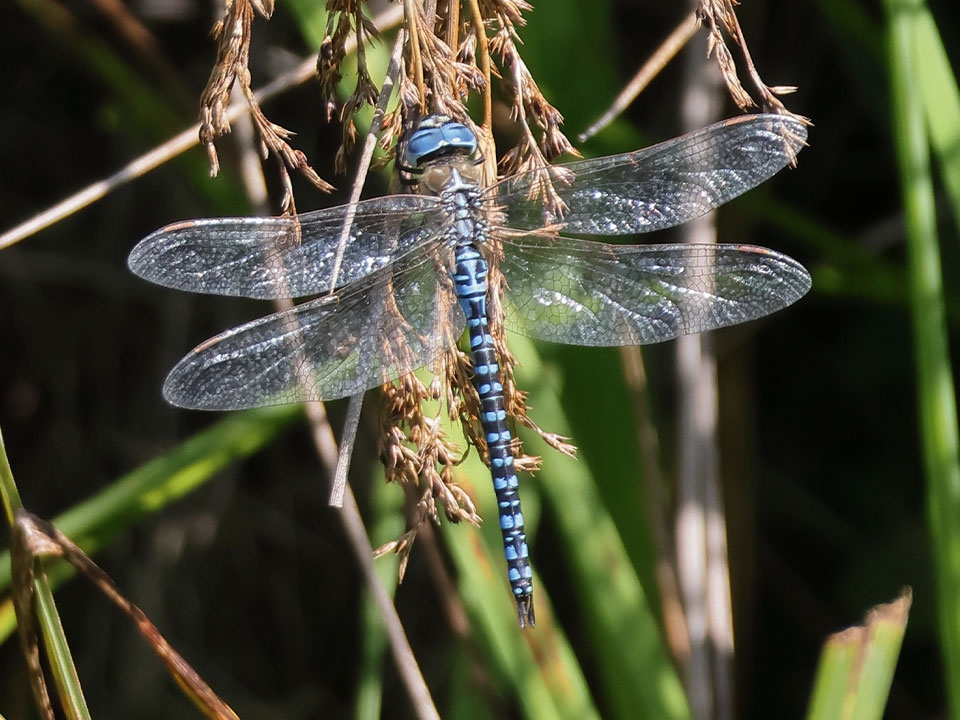
Southern migrant hawker (Aeshna affinis) at Slimbridge, August
Roberta Goodall, WWT volunteer
The challenge
I volunteer as a ‘Guide-in-a-hide’ for the Reserve team at Slimbridge and an enjoyable activity during the summer months is getting to drive and guide on the wonderful ‘Wildlife Safaris’. The safaris let us take visitors out into the northern part of the reserve, to areas not normally accessible to visit on their own, or on foot. The north 100acre reedbed has always been an excellent site for dragonflies and damselflies but a few years ago the reserve team created a series of wildlife ponds on the edge of the ‘goose fields’ along with wildflower rich areas between them. These are beginning to pay dividends in terms of new ‘odonata’ species turning up.
This gorgeous southern migrant hawker is one of the more recent arrivals on site, and this one was seen at the end of August, on a dry fairly sunny day, at one of these ‘new’ ponds. This is a species that is slowly spreading north and west and at Slimbridge we are quite close to edge of their current range. However, we are seeing them more frequently so definitely a species to look out for on our safaris or around the ponds on site.
Getting the shot
I often have my camera beside me in the Land Rover, I am currently using a Canon R7 with a 100-400 lens, although I hadn’t had it for very long when I took this shot. It was taken (using aperture priority and auto iso) at F8.0, ISO500, 1/500 seconds at 400mm. The image was cropped slightly on my computer at home. Although a lovely sunny day, zooming in seems to increase the ISO when set on auto.
Hawkers are wonderful to begin one’s attempts at photographing dragonflies as they will often perch like this for a while, giving one an opportunity to grab a shot.
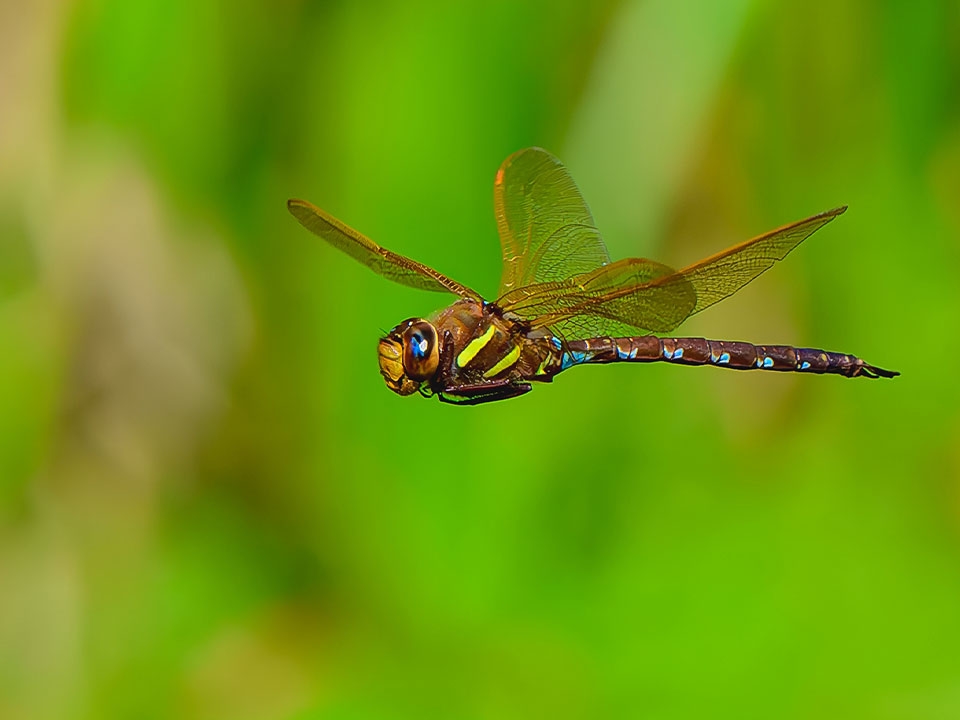
Brown hawker (Aeshna grandis) at Washington, August
Mark Whitelock, WWT supporter
The challenge
My image of a brown hawker was captured on a weekend at WWT Washington when I captured more insects than birds for a change! This brown hawker was flying over the amphibian ponds and took quite a bit of patience to capture. The pattern it flew wasn’t predictable, and rather than try and track it with my lens, I chose to set a focus trap by focusing on the water lilies in the water and approximate where it would be flying, then using focus peaking of my mirrorless camera to manually adjust the focus as it flew across.
Getting the shot
I started at shutter speed 1/2000th and aperture at f/8, but soon found moving up to 1/4000th at f/10 and ISO 4000 on my 180-600mm lens increased my chance of capturing the hawker in focus. Not too much noise and it was fast enough to freeze the action. I took a lot of photos over 10 mins to get this image. I capture most of my images on my Nikon Z9, however, I’ve just received a Nikon Z50ii, and it’ll be interesting to see how well I can capture wildlife in comparison. Looking forward to more dragonflies this year at WWT Washington.
WWT wetland centres provide an incredible opportunity to get up close to these beautiful creatures and try your hand photographing them.
Remember as with any wildlife photography, be sure not to disturb the animal. If that happens, change your approach; it’s important not to stress them. And just as importantly, take real care not to damage any habitat, even flattening grasses, as they could be key perching posts.
Discover our Dragonfly Festival summer of events and activitiesHeader imager: Migrant hawker in flight © Paul Stevens

